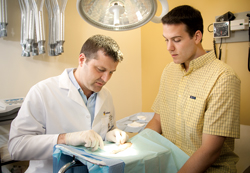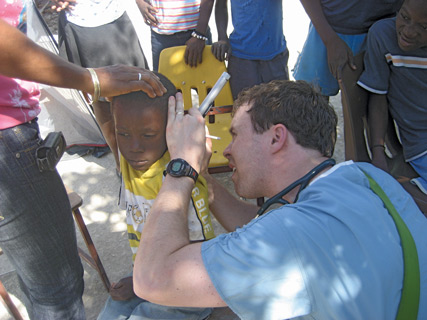Summit covers myths and evidence of competing with clinics
Providers and administrators of retail medical clinics try to assess the evidence base behind the care delivered at these facilities. Office-based practitioners ignore the increasing number and expanding capabilities of storefront medicine clinics at their peril.
At a typical medical conference, there's not a lot of talk about brands, business models and market penetration. The National Retail Clinic Summit is not a typical medical conference.
Providers and administrators from the walk-in clinics, which are located in drugstores, supermarkets and storefronts around the country, gathered in Philadelphia in March. There was much sharing of business strategies, but speakers at the meeting also addressed a number of common assumptions about retail clinics, separating the myths from the evidence-based facts.

If the health care system ignores retail clinics, they'll go away. Although this assumption might provide comfort to clinicians worried about competition, it's refuted by existing research on business markets, according to Jason Hwang, ACP Member, executive director of health care at Innosight Institute, a think tank.
Retail clinics are a disruptive innovation in the health care industry, just as personal computers and transistor radios were in their respective industries, Dr. Hwang explained. These new products and services appear when the existing offerings, health insurance or out-of-pocket payment for a doctor's visit in this case, are too expensive for some consumers.
“A new provider comes in with a lower-cost model to provide those services, starting with just the simple stuff, but improving from that point,” Dr. Hwang explained.
An ongoing shift from intuitive medicine to rules-based care spurred the retail clinic model, he said. Physician expertise will always be necessary for complex medical problems. However, as common diagnoses become more technology-based (rapid strep tests, for example) and treatment more guideline-driven, nonphysician providers who typically staff retail clinics are able to provide more care on their own, he suggested.
“In the intuitive world, quality means having access to the best physicians,” said Dr. Wang. “As you move increasingly to rules-based care, the marker changes to affordability and convenience.”
The meeting's next speaker assessed retail clinics on several quality markers and refuted another common assumption about the industry.
Retail clinics provide a lower quality of care. As a researcher for RAND and a professor of medicine at the University of Pittsburgh, Ateev Mehrotra, MD, was interested in assessing the validity of physicians' and policymakers' concerns about retail clinic quality.
He led a study that compared quality of care for otitis media, pharyngitis and urinary tract infections with that provided by physicians' offices and emergency departments. The care was scored on factors such as appropriate testing and use of antibiotics.
“It's a consistent story,” Dr. Mehrotra said of his study's findings. “We're not seeing any differences in the quality of care that's provided by retail clinics compared to doctor's offices and emergency departments.”
The study, which was published in the Sept. 1, 2009 Annals of Internal Medicine, also looked at the impact of retail clinics on preventive care. Since acute care visits often provide an opportunity for physicians to remind patients about preventive care, there was concern that patients who were treated at retail clinics would be less likely to get needed immunizations and screenings, Dr. Mehrotra explained. However, over the three months after their acute visit, the patients had very similar rates of receiving preventive care.
Dr. Mehrotra's study also addressed another common concern about retail clinics.
Retail clinics are pulling patients away from primary care practices and hospitals. In fact, in another study published in the September/October 2008 Health Affairs, almost two-thirds of the patients who visited the retail clinics said they had no primary care physician. “That's in contrast to some surveys that have been done of the population as a whole, where about 80% of the patients in the country report a usual source of care,” said Dr. Mehrotra.
“One of the concerns was that retail clinics were going to disrupt primary care relationships. We make the note that a lot of the patients going to retail clinics don't have a primary care relationship to disrupt,” he added.
The statistics may have changed since the study was done in 2005-2006, Dr. Mehrotra noted. However, recent years have only seen an increase in the need for primary care physicians, according to Michael O’Neil, CEO of a retail clinic, MedPoint Express, and the COO of Memorial Hospital and Health System in South Bend, Ind.
“The demand is getting greater and greater and greater. None of us make money on primary care,” he said. For that reason, Mr. O’Neil sees more integration between hospitals and retail clinics as both a likely and a good development. “You're meeting your need for primary care. You're developing a referral stream into your specialists. You've got a good model and you're providing the right care in the right place,” he said.
As Mr. O’Neil noted, the challenge of providing the right care in the right place is a major issue in health care reform. However, some limitations in the ability of retail clinics to accomplish this goal were discussed by other attendees at the summit.
Retail clinics can fix primary care access problems. “Retail clinics have been widely discussed as a private-sector solution to the shortage of primary care,” said Craig Pollack, MD, also a RAND researcher and assistant professor at George Washington University in Washington, D.C.
To assess the accuracy of this assumption, he and colleagues studied the location of retail clinics. The results of their August 2008 survey, which were also published in the Sept. 1 Annals of Internal Medicine, found that 28.7% of the U.S. population lives within a 10-minute drive of a retail clinic, and 10.6% lives within five minutes.
However, in another analysis, Dr. Pollack found that the clinics are not necessarily closest to the patients who have the greatest need for their services. He compared the location of clinics with urban neighborhoods that have been classified as medically underserved by the federal government.
“There are some retail clinics that are in medically underserved communities, but by and large, the distribution tends to be away from medically underserved areas,” Dr. Pollack said. The association held true even when the researchers accounted for the lower density of chain stores (which could potentially hold retail clinics) in the underserved areas.
The tendency of patients without primary care access to seek nonurgent treatment in emergency departments has been widely discussed and decried. Presumably, if those patients went to a physician or retail clinic instead, the health care system would save money. But it's unclear whether retail clinics actually lead to these savings, according to Dr. Mehrotra.
“This is an open question that needs to be addressed in future research,” he said. Some insurers have conducted studies to see if the presence of retail clinics is associated with a change in overall health care utilization and haven't found any significant difference, he said.
“The concern is are you going to take the worried well who would have just stayed at home and now are going to start going to retail clinics, and therefore, increase utilization and increase costs or at least wash out the savings?”
Retail clinics reduce health care costs. “In theory, there's a huge potential savings,” said Dr. Mehrotra. His study of the quality of care provided by retail clinics also looked at cost. For all three conditions, otitis media, pharyngitis and urinary tract infections, the cost of care was lower at the retail clinic than at physician offices, urgent care centers and emergency departments ($110 vs. $166, $156, and $570, respectively).
The low and transparent cost of care has also been a major factor attracting patients to the clinic, he noted. “The fact is, you know exactly how much it was going to cost and that was very attractive to the uninsured,” Dr. Mehrotra said.
The problem arises if the clinics make their services so attractive that patients actually spend more on health care. Because of that possibility, RAND's estimates on the potential health care savings offered by retail clinics range from nothing to $4 billion per year. Research done for the Institute of Medicine has taken a more positive outlook, projecting savings of $2 billion to $7.5 billion.
Even the upper end of these estimates wouldn't put much of a dent in overall health care expenditures, Dr. Mehrotra said. “Even though retail clinics could save billions of dollars, it's less than 1% of health care spending in the U.S. Obviously, it's not a panacea.”
Other speakers at the meeting were more optimistic about the potential of retail clinics to fix the U.S.'s health care problems. Their predictions are predicated on changing one of the most basic assumptions about retail clinics.
Retail clinics are only for acute care. In Dr. Mehrotra's research, he found that a few conditions made up the majority of services provided by retail clinics: common infections (upper respiratory problems, conjunctivitis, etc.), immunizations, and basic lab tests.
“We have a short list of offerings,” confirmed Sandra Ryan, RN, chief nurse practitioner officer of Take Care Health Systems.
However, during a summit session on changes in retail clinic scope of services, she and Donna Haugland, RN, chief nursing officer of MinuteClinic, proposed a major expansion.
“We in retail health care think we are perfectly positioned to help control chronic disease,” said Ms. Haugland. She noted that the U.S. has high rates of undiagnosed diabetes and even diagnosed patients failing to get routine care like A1c tests.
Retail clinics could address these issues by getting more involved in identifying patients with problems like high glucose or blood pressure, educating those patients once they've been diagnosed (teaching skills such as insulin injection) and providing routine monitoring of chronic conditions, Ms. Haugland said.
Service expansion awaits only acceptance from other clinicians and payers, since patients are ready now, according to Ms. Ryan. “We have done some research that really showed that people were willing to come to the clinic for high blood pressure, for asthma, for high cholesterol,” she said.
Ms. Haugland is optimistic that this more intensive collaboration between traditional primary care and retail clinics will soon come to fruition. “Hopefully, as the integrated health care systems evolve and mature, we will be able to work more closely to ensure patients actually get their needs met.”
It remains to be seen if her prediction will be a myth or a reality.





